There are few recurring global exhibitions of contemporary art more renown, prestigious and selective than dOCUMENTA, held every five years in Kassal Germany. Which is what makes it so very remarkable that one of the highlights of last year's dOCUMENTA 13 was the inclusion of a refugee encampment made by what are arguably among the least known people on the face of the earth--the Sahrawi of North Africa.
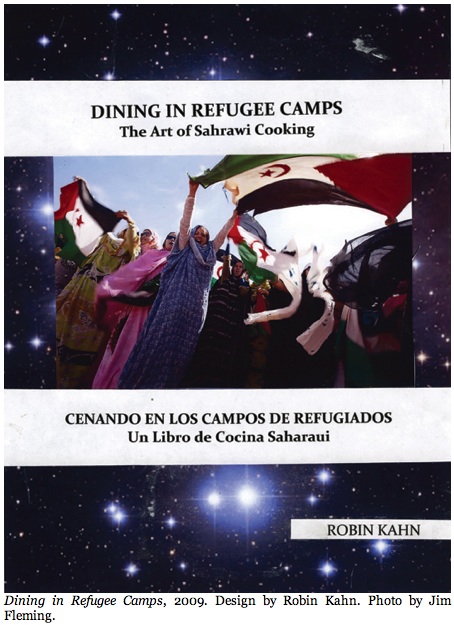
Organized by New York artist Robin Kahn, philosopher Peter Lamborn Wilson (aka Hakim Bey), and dOCUMENTA 13's Creative Director, Carolyn Christov-Bakargiev, and with photo documentation by Artforum critic Kirby Gookin and artist Edi Escobar, the installation was intended to bring attention to the Sahrawi's 38-year struggle for independence. Even more remarkable is that the cross-cultural collaboration came about as the result of a dream. Not a dream of success, as the art world is plethorically marked by, but by a literal dream that came to one of the organizers when asleep. As for whose dream and what it led to, I defer to Robin Kahn's exuberant account below.
I will state that the installation centered around the women members of the Sahrawi Camp largely for two reasons: The Sahrawi Refugee Camp is becoming known to us in part due to Robin Kahn's book, Dining in Refugee Camps: The Art of Sahrawi Cooking, which introduced the Sahrawi to what may be their first contemporary audience in the Americas and Europe outside of ethnological studies and such human rights watch organizations as Amnesty International. But more pertinent to the Sahrawi is the fact that the concentration on women at dOCUMENTA 13 is due to its being a largely matriarchal society, whereby women contribute vitally to the subsistence of its people.
As part of my ongoing project of nomadically searching out cultural expressions from outside the West, and even the more mainstream global cultural centers, I found this just-published interview in the new e-zine MOMMY, curated and published online by New York artists Susan Silas and Chrysanne Stathacos. Besides that MOMMY in each issue introduces vital art made by women artists, it also reminds us that some theories of the orgins of prehistoric art have art being made in mimicry of women's power to give birth (at a time when fathers and paternity may have yet gone undiscovered). But whatever our history, MOMMY today offers us compelling proof that women artists supply a vital component to the avant-garde in both cultural and political affairs.
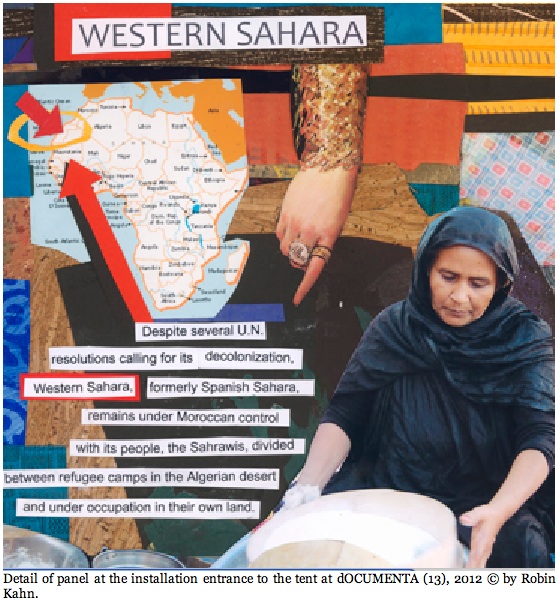
MOMMY's coverage of the dOCUMENTA 13 collaborative tent and dining by the Sahrawi women and Robin Kahn is the e-zine's first foray outside the Western art world.
The interview is extensive and can be read in its entirety on MOMMY. Here is its beginning.
SUSAN SILAS:
First, I would like you to tell us how you came to be in dOCUMENTA 13, because it is a lovely story.
ROBIN KAHN: My journey started in 2009 when I participated in ARTifariti, an "art and human rights" festival that takes place in the Tindouf Refugee Camps in Algeria, where two thirds of the population of Western Sahara have been living in exile since 1975. I learned about the festival from Federico Guzmán (with whom Kirby [Gookin] and I have worked collaboratively on various projects over the past 20 years) who was writing a blog about his experiences in the camps the year before.
Looking at his photos and reading about the recent history of the country, all of a sudden I stopped and thought: "Wait a minute. I'm an educated person, why have I never heard anything about this place, the Sahrawi people, and their ongoing struggle for independence?" I'm talking about a country in North Africa on the Atlantic coast that was illegally occupied 38 years ago by the kingdom of Morocco. Obviously there are a lot of legal questions involved but basically during Spain's withdrawal from the territory (formerly called Spanish Sahara), Morocco invaded by dropping bombs and napalm on the defenseless population. The Sahrawi men remained at the front to fight off their aggressors while the women led the oldest and youngest members to safety across the Saharan desert into Algeria, where they have been living as refugees ever since.
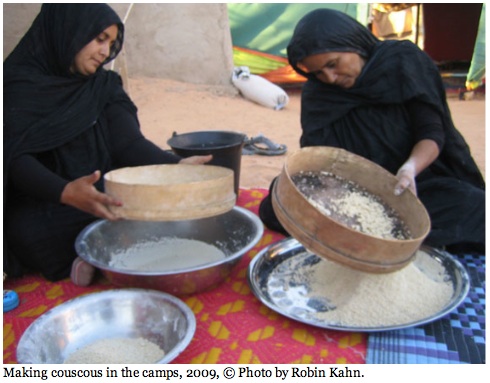
When Federico was telling me about his experience, I realized, wow, I really want to learn about this myself and not hear about the political situation as UN statistics about war and peace. So I wrote a proposal to go to the five camps and live with a family in each, to prepare meals with the women in their kitchens and eat with their families and just by hanging out in their daily routine, I would get to hear their stories about what happened in this country and what this crisis is from the people themselves, particularly the women. My idea was to create a project about cooking, something that I do everyday at home--a shared language--to compile their women's recipes, stories and memories into a book that describes not only their dishes but also how they have built their lives and kept hope alive in this extreme situation of occupation, war and exile.
When I went to the camps and I had this experience that was like nothing I've ever had before. It's a completely matriarchal society there. The women built everything--all of the infrastructure: the buildings, an educational system where there is 99% literacy. They wrote a constitution-in-exile in 1976 guaranteeing women's equal rights, and this is in a Muslim country! So, what we as Americans think of Muslim women was completely turned on its head for me. What I experienced was a truly cooperative society, even though it is a society-in-exile. The women work in a way that is really interesting. They have formed cooperatives to organize and oversee all aspects of the educational, cultural, political and family life in the camps. Each cooperative has a distinct role to play that can only work in relationship to how it is serviced by and how it services the people at the same time.
I've always tried to design projects that engage people and grow beyond my own authorship. It is the sum total of everybody's engagement and interaction that creates a truly collaborative project. And so when I went to the camps and I lived with families and I got to know them, I was truly amazed by the success of the women's structured cooperation. They are living in the hottest part of the Sahara where no food can grow and they have to, not only to feed their people, but also keep Sahrawi tradition, culture, and history alive for their children who were born there and have never set foot in their own homeland, in their own country. The Sahrawi people are patriotic, proud and happy in this unbridled way that--I mean, it's a very complicated question--but their sense of purpose, creativity, intelligence, and effort are all directed toward and motivated by one common goal--survival. Every effort is a total commitment.
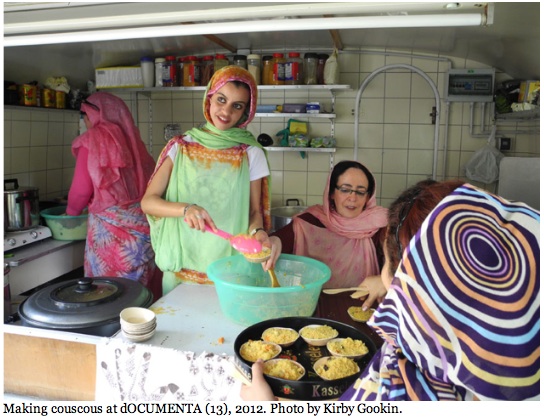
Here's an example of what I'm talking about in terms of food. I followed the women when they would pick up supplies from humanitarian aid announced that day on posters at the main square. A monthly ration of flour or onions would be dropped out of trucks at a specific time and place. They would help each other carry these huge bags of provisions to each other's homes. If one person had a sore leg, then her neighbors would assume the responsibility without hesitation. In my home in Camp 27, my hostess Salma Ali had a wounded arm and couldn't make bread in the morning, so her friend Galia made two loaves every morning--one for her family and one for us ... and that's just the way it is.
Each family is issued a standard UN white tent. So from the outside, they all look the same. But once you go inside, each home is so unique, so colorful and comfortable, and all handmade! Consistent with their Berber origin, this tent or "Jaima" functions as the center of family life. This is where everyone takes their meals together, which is a very long time honored process. It begins with a long tea ceremony where, in between multiple brewings, you relax, play or enjoy music. Then large plates of food arrive. As you share various inventive and delicious dishes, you start talking about who you are and they start telling you their story. In between helpings, you might break off into smaller conversations or grab a pillow and take a nap.
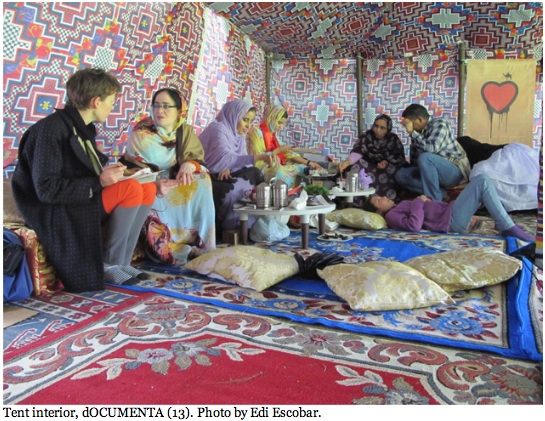
Many times when I arrived at people's houses, I was asked, "Would you like to take a shower?" The first time, I thought, "Why, am I smelly?" But actually you are so hot, it's 102 degrees everyday. The "bathroom" is a small anteroom with no plumbing but what they are offering you is--just to go into this dark cool private space and take a bucket of water and pour it over your head and put your clothes back on and feel rejuvenated when you rejoin the group. So I did that and I understood. This is the kind of Sahrawi hospitality that has welcomed strangers into the fold for centuries and it is still operative--it's a cultural tradition about bringing people together. And through rituals like this you get to know each other. That is how I learned about the Sahrawi people--about their history, their culture, and the nature of their struggle today.
SUSAN SILAS: So, do you think this tradition developed there, in the camp?
ROBIN KAHN: I think they are nurtured there, but they come from the memories of little girls who are now the matriarchs, who are my age and older, who escaped.
CHRYSANNE STATHACOS: Were they a nomadic culture?
ROBIN KAHN: Yes, they were originally a nomadic culture made up of tribes. European colonial powers in the mid-1880's set up the Western Sahara and above it is the French colony of Morocco. So the Moroccans do have an argument that they were in there earlier too because the lines were arbitrarily drawn. But the thing is the Moroccans inherited their country as it was inscribed at the time of independence and now they have illegally occupied the country of Western Sahara so where are the Sahrawis supposed to live?
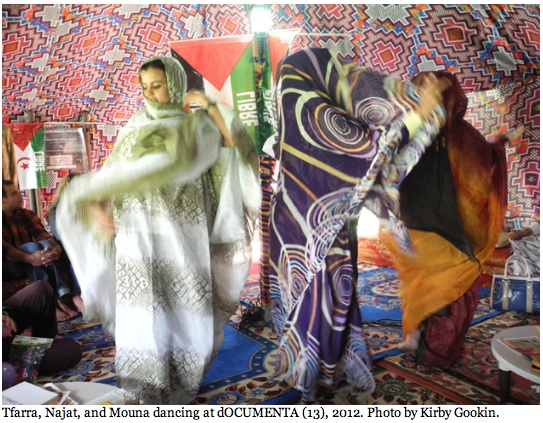
CHRYSANNE STATHACOS: So the French drew those borders?
ROBIN KAHN: No, colonization was a complicated European initiative. The Sahrawi people are Berbers, Saharan Africans and Arabs. In the camps today, there is a real mixture of colors, cultures and histories all living together as families. It's as close to a society in terms of mixing that I've experienced as New York. Being a mom of color, which I am, because I've adopted a daughter who is African-American, when we travel I am very conscious of how she is going to feel and be treated in a new community. In this Sahrawi culture, here in the middle of the desert, the people have so many different stories about how they became a family. A mom might introduce her family to you and there are six daughters and they're all different colors and that's just the way it is.
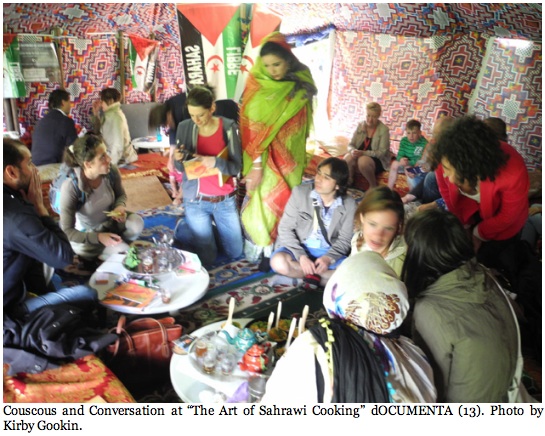
SUSAN SILAS: And one product of your day to day experience with these women was a cookbook?
ROBIN KAHN: I created Dining in Refugee Camps, The Art of Sahrawi Cooking in the camps in 2009 and brought it back to NYC with the idea of approaching NGOs to fund its publication. That's a new community for me, because I am used to working strictly within the art community, but I wanted to get this project beyond that sphere. But each NGO told me the same thing: "This is beautiful, this is really about empowerment and visibility but Western Sahara is not on our list." "What do you mean? These people who have been living in camps for 38 years are not are your list?" "Well, America doesn't actually support the Western Sahara Cause, so we can not give you funding." So that negative reaction is what sent me running to the anarchist publishing collective autonomedia where Jim Fleming heartily agreed that is was a very important project to support. Let Anarchism Rule the Day!
And to top this good deed off, Jim then gave a copy of my book to another member of the autonomedia collective, the anarcultural writer and mystic philosopher, Peter Lamborn Wilson (aka Hakim Bey) , who was to conjure the prophetic dream that would soon land me at dOCUMENTA. A few days after he read my publication, he had lunch with the exhibition's Creative Director, Carolyn Christov-Bakargiev and he told her that the night he had finished reading my "cookbook-in-solidarity with the people of Western Sahara," he dreamt that Sahrawi women were cooking couscous in Kassel...and the rest is The Dream Come True!
Peter called and left a message on my answering machine introducing himself and asking, "Would you like to be in dOCUMENTA?" Insane...but it's great. So I've travelled from the middle of Manhattan to the furthest, most invisible place imaginable--refugee camps in the hottest part of the Algerian desert--and reappeared in the dream state of dOCUMENTA .

Peter and I worked together on generating the ideological structure of the piece. My friend, the anthropologist Mick Taussig, an advisor to the exhibition, was instrumental in supporting the project too AND he wrote a great catalogue essay about it.. I thought: "If I'm invited, no way can I do a project about a Sahrawi cookbook that doesn't involve people from Western Sahara." So I went back to the camps in 2011 and I met with the women's cooperatives that run the five camps and told them about the invitation and we came up with the idea of an installation that would center around a tent (or Jaima), a typical Sahrawi home made by women in the camps. We would transport a home-in-exile from Algeria to the Karlsruhe Park in Kassel as a symbol of peaceful refuge and see how it can interact with the environment.
Read the entire interview at MOMMY.
From February 1-3, the editors of MOMMY will be at the Printed Matter LA Art Book Fair, held at The Geffen Contemporary at MOCA, 250 South Grand Street, Los Angeles, Room E, table 6. http://laartbookfair.net/ .
